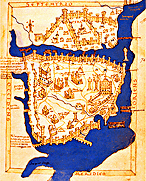 |
|
 |
Italian merchants: their role
 he conquest of Constantinople in 1204 marked the beginning of the
he conquest of Constantinople in 1204 marked the beginning of the
 firm establishment of the Venetians, first,
and of the Genoese, later, in the eastern Mediterranean. The Byzantine state, which had controlled the privileges and the presence of Italians on its territory, was now replaced by the Latins, a fact which favoured the development of Italian commercial activities. After the recovery of Constantinople by the Byzantines, the Italians secured a number of privileges and annexed certain Byzantine lands of strategic and economic importance to them in order to control the sea routes. The Byzantine merchants and bankers were now playing a secondary role. firm establishment of the Venetians, first,
and of the Genoese, later, in the eastern Mediterranean. The Byzantine state, which had controlled the privileges and the presence of Italians on its territory, was now replaced by the Latins, a fact which favoured the development of Italian commercial activities. After the recovery of Constantinople by the Byzantines, the Italians secured a number of privileges and annexed certain Byzantine lands of strategic and economic importance to them in order to control the sea routes. The Byzantine merchants and bankers were now playing a secondary role.
The Genoese
and the Venetians were the ones who dominated
the commercial scene. The relations between the two maritime republics were hostile and antagonistic, as each of them tried to gain the upper hand. This antagonism, which had already existed before then, became even more intense after 1204 and mainly in the 14th century. A third important commercial and maritime power was Pisa, which retained the privileges it had acquired in the time of the Komnenoi. However, its defeat in 1284 by the Genoese put an end to its presence in the eastern Mediterranean.
There were also instances in which
an individual benefited from the policies of the Byzantines. A case in point is that of the two Genoese brothers, Benedicto and Manuel
Zaccaria
, to whom, in 1275, Michael VIII gave the city of Phokaia as a pronoia. Thus, the Zaccaria family acquired considerable economic power by exploiting, first, the alum production of Phokaia in Asia Minor and later the production of mastic gum and wine of Chios.
The Italian trade was of course directly dependent on the economic and political situation of Western Europe and the Far East. The end, in 1340, of the
Mongolian Peace
, which had contributed to the development of the trade in luxury items from the Far East, had a negative effect on this commerce. At the same time, the economic and demographic crisis faced by Western Europe in the 14th century signalled the beginning of the decline.
|